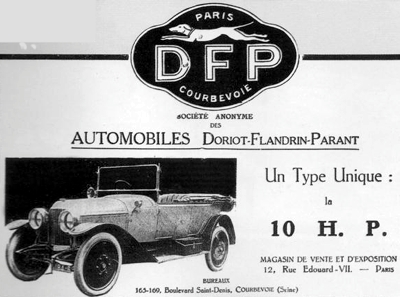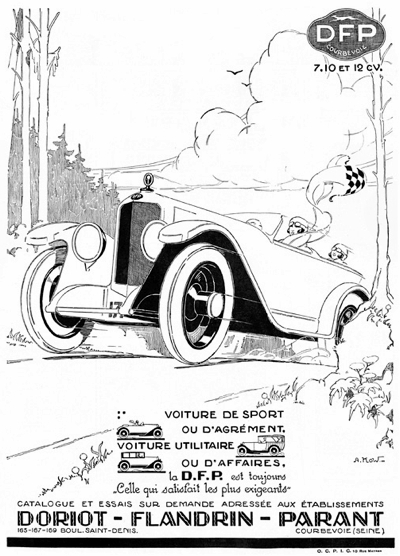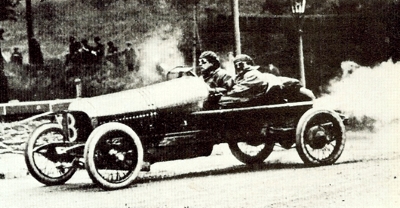Doriot was one of Peugeot's principal racing drivers during the 1890s, with several modest successes to his name. It is even recorded that he followed the 1891 Paris-Brest cycle race in a Peugeot.
Doriot went into partnership with a Monsieur Flandrin in 1906, building single-cylinder, shaft-drive voiturettes of no special merit, at Courbevoie, Seine; shortly after this, a Monsieur Parant became a partner in the company. As the name Doriot-Flandrin-Parant was too cumbersome for general use, the cars became known as DFP, which French wags rendered as 'Derniere Ferraille Parisienne' (Latest Paris Scrapiron).
The 1.1-Iitre singles lasted until 1910, but were by then overshadowed by the firm's four-cylinder models, introduced in 1908 with 2.4 and 2.8-liter Chapuis-Dornier engines, and joined in 1910 by the 10/12 hp, 1.6-liter model, which really established the marque. Further, the 10/ I2 was the first DFP model to be launched on the British market; the agent was G. A. Lecoq of New Bond Street, already well known as the manufacturer of Vuitton suitcases and trunks.
Lecoq claimed that the DFP had proved in every respect the most successful small car of 1910, and forecast that in 1911 it would be even more phenomenally successful. Compared with many of its contemporaries, the 10/12 was advanced in concept: the valves were enclosed and the propeller shaft worked inside a torque tube.
It was extremely light, economical on tyres and would do forty miles an hour and 35 miles to the gallon. Priced in the UK at £235, complete with two-seater body, the DFP cost much the same as the better British light cars like the Calthorpe; already, though, there were signs that added performance was becoming a desirable feature, as a 10/14, overbored for extra power, was added for 1911, which also saw a brief and uncharacteristic venture into six big cylinders with a 20/25 model that failed to see the year out.
Lecoq had a single-minded interest in making money, but was obviously more adept at marketing trunks than motor-cars, and by the early part of 1912, the British DFP operation was in urgent need of additional finance. 'We do not sell the DFP by advertising, but by reputation,' claimed Lecoq, who by this time had established a sales and service depot off Hanover Street, and he added optimistically, 'one satisfied owner tells another, and there are no DFP owners who are not satisfied'. Whether they were satisfied or not, there simply weren't enough DFP owners to make the business viable, and sales fell to a low one a month.
W. O. Bentley
Lecoq advertised for a director with money to invest. A young man, H. M. Bentley, replied, having decided that the opening would suit his younger brother Waiter, who was at that time managing a fleet of Unic taxis at Hammersmith. So W. O. Bentley came into the business, for £2000, and found that Lecoq was just a sleeping partner, while the other director, Fernie, was 'noisy, bossy and ineffectual'.
The DFPs themselves were well made, reliable cars, with above average performance, especially the new 12/15, introduced at the end of 1911, with a 2-Iitre engine built by DFP. This power unit had three main bearings, with positive lubrication by a pump which also fed the troughs for the splash lubrication of the big ends; it could spin freely up to 2500 rpm, and gave a top speed of 55mph.


 DFP 12/40 at the 1914 Isle of Man TT Race.
DFP 12/40 at the 1914 Isle of Man TT Race. |
The cars had a future on the British market, thought Bentley, although it was liable to be a short one with Lecoq and Fernie in charge. H. M. Bentley bought them out in April 1912, for another £2000, and the firm of Bentley and Bentley came into being with far too little working capital but a great deal of confidence. One sure way of publicising the DFP - and, hopefully, of gaining some extra sales - was to win one of the major speed events. So with a car tuned by Leroux, a mechanic sent over to Bentley and Bentley from the DFP factory at Courbevoie, W. O. Bentley won his class in the June 1912 Aston Clinton hill-climb at record speed.
Later that year, a streamlined single-seat 12/15 set up a new ten-lap record of 66.78 mph at Brooklands. Bentley was anxious to get still more performance from the car, but was limited by the pistons, which could not withstand the high speed. The answer came, by chance, in 1913, when W. O. Bentley visited Doriot at Courbevoie. On the Frenchman's desk stood a novelty paperweight from the Corbin foundry: it was a tiny piston made from aluminum. Against Doriot's advice, Bentley had a set of 12/15 pistons cast in aluminum alloy, raised the compression ratio and found an immediate improvement in the power output.
After much testing to determine the correct weights and clearances for the pistons, Bentley ordered Courbevoie to build an aluminum-pistoned engine for a sporting variant of the 12/ 1 5, to be known as the 12/40 Speed Model. This was not the first time aluminum pistons had been used on a car - Professor A. M. Low had fitted them to his Gregoire - but the idea was still extremely novel.
The result of using the new pistons in the racing single-seater was phenomenal. At the August 1913 Brooklands meet, the DFP won the Short Handicap at 70.5 mph, and showed itself capable of lap speeds of over 75 mph. Its main rival was the 2-Iitre Humber driven by W. A. Tuck, which had, up to then, just managed to top the DFP's performance. True to form, the Humber raised the ten-lap figure at Brooklands to 79.63 mph and the half-mile to 85.53 mph.
Bentley and Leroux worked on the Speed Model DFP single-seater, however, fitting it with two spark plugs, and lightening the chassis. After this, just about every record in the book fell to the car, which covered the flying half-mile at 89.7 mph; the Humber retired from the circuits.
Alongside these competition successes, Bentley had built up a reputation for flair in coachwork design: at the 1912 Olympia exhibition, for example, he showed a four-seater tourer, which was, it was claimed, the first-ever car to be panelled in polished aluminum. Even the ‘heavy and sluggish' 16/20 hp model had a share in the elegance, for on the same stand was a two-seater coupe limousine on this chassis; painted dark purple, it was panelled in sycamore and upholstered in doeskin.
In June 1914, Bentley entered a 12/40 in the Isle of Man Tourist Trophy race. Apart from its airship-tailed body, it was virtually a standard vehicle, so that its final position of sixth, behind purpose-built 3.3-liter cars in the race, achieved widespread publicity, seventeen out of the 23 racers taking part failed to finish the gruelling Isle of Man race.
In mid July appeared the advertisements boasting the 12/40's sporting achievements - in the Caerphilly Hill-Climb and the Porthcawl Speed Trials as well as the TT - but before the expected orders poured in, the Germans had declared war, and the operations were suspended during the hostilities.
After the Armistice W. O. Bentley was busy developing his new 3-liter sports car (the prototype was built in the DFP agency's service garage at New Street Mews), but H. M. continued to run Bentley and Bentley with great success during the post-war boom. He made £20,000 in the first year after the Armistice, and drivers were rushing chassis from the factory to the Channel ports to meet demand.
When the boom went off the boil, however, Courbevoie went into a rapid decline. The last competition version of the old 12/40 appeared at Brooklands in the early 1920s; it was owned by Henry Birkin (later one of the most distinguished Bentley drivers) and had a curious Consuta-sewn plywood body, built on the same principle as Saunders-Roe flying-boat hulls.
The basically Edwardian 12/40 and 10/12 lasted until 1923; and the 10/12 was still listed the following year, although a reduction in chassis price from £430 to £325 made it pretty clear that the new agents, Ward & Driskell, who had taken over the Bentley and Bentley concession (and their North Audley Street showrooms) in mid 1923, were just trying to clear unsold stocks.
A new model, the 9.5 hp DF Petite, appeared in 1922, but wasn't available in Britain until 1923. With an 1100 cc pushrod ohv CIME engine, it was a lively voiturette, akin to the Amilcar. The 1923 Motor Show car was a bright-red cloverleaf three-seater, with mahogany decking, and at a cost of £295 it was passable value for money. There was one last sporting venture: one of the voiturettes took second place in its class in the 1926 Bol d'Or, and in 1927 a similar model won outright. But the victory was too late, and in 1926 the factory closed down for ever.
